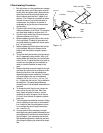
21
seat switch, the blade clutch switch and the
electric blade clutch. Then check the seat
switch, the blade clutch switch and finally the
electric blade clutch.
E.Tires
The two front wheels are caster wheels that are free to
swivel to accommodate the direction of the mower.
The two rear wheels are used to propel the mower in the
direction of input from the drive handles. Inflation
pressure of the rear tires is important for stability while
the mower is in operation. If the tire diameter is not
equal between the two tires, the mower will pull to one
side.
1.
Inflation Pressure:
a. Traction Tires—20 psi max; 8-10 psi recom-
mended
b. Front Caster Wheel—28 psi max; 20-25 psi
recommended
c. Cutting Deck Ball Wheels—Solid Polyure-
thane.
Use the Following guidelines for maintaining the tires:
a. Balance inflation pressure between the rear
tires to help maintain straight travel (see tire
side wall for proper inflation pressure).
b. Keep the valve caps tightened to prevent air
pressure loss.
2.
Leaking Tires:
When a flat tire occurs, repair or
replace immediately. The normal procedure is to
remove the wheel and replace it. If a tire is get
-
ting soft, park the mower on the nearest level,
paved area. If the leaking tire is on a traction
wheel, put blocks on each side of the opposite
traction wheel and jack up the tire that leaks
about an inch off the ground. Loosen and
remove the lug nuts and remove the wheel.
Mount a wheel and tire, replace the lug nuts, and
using a torque wrench, tighten them to 60
±
10
ft-lbs.
If the leaking tire is on a front caster wheel,
block both traction wheels and raise the caster
wheel so that the tire is an inch off the ground.
Loosen and remove the locknut from the axle
assembly and pull the axle assembly from the
caster yoke. The wheel and two spacer sleeves
will drop free. Slip the axle assembly through
one side of the caster yoke, through a spacer
sleeve, a wheel, the other spacer sleeve and
finally through the other side of the caster yoke.
Then tighten the locknut on the end of the axle
assembly.
Lower the mower off the jack and continue
mowing. The wheel with the leaking tire should
be inflated to 20 psi and the wheel placed in a
large bucket of water. Carefully inspect the tire,
rim and valve for escaping air bubbles which
indicate a leak. Mark each leak with a yellow
marking crayon and then deflate the tire to 8 psi
and repeat the inspection. If the leaks you find
are pin hole size to 1/16" diameter, the tire can
be repaired. If the leaks are larger than 1/16"
diameter, the tire can be repaired. If the tire
bead is damaged, the tire can be repaired or the
tire will have to be replaced.
3.
Creeping:
Creeping is the slight forward or
backward movement of the mower when the
throttle is on and the lapbars are in the opened-
out position. If your mower creeps do the follow
-
ing.
a. Jack up rear of unit.
b. Place Lapbars in the neutral position.
c. If the tires are rotating, the neutral position
that side transaxle linkage will need to be
adjusted. Contact your service representa
-
tive.
F. Brakes
While the mower is in motion, all braking is performed
dynamically through the hydraulic pumps and traction
motors, controlled by the two steering levers. When the
mower is parked with the engine shut off, the hydraulic
system locks the traction wheels.
Note: To move the mower forward or in
reverse by pushing, you must release the
dynamic braking. Locate the release levers at the
rear of the machine. Pull them toward the rear
and lower the wide area of the rod into the key
-
hole slot. (See photo below)
Hydro Release Valve
.
When the mower is parked with the engine running and
the steering levers in the neutral position, the parking
brakes should be applied. The parking brakes are
internal gear/pawl brakes mounted in each transaxle.
They are both engaged by the same operating lever.
1.
Adjustments:
The parking brake handle is an
over-center lever in a slot that should engage
with moderate force. The parking brakes pro
-
vide a positive means to hold a machine station-
ary that is similar to “Park” on an automobile.
Note: The parking brakes normally do not
need to be adjusted.
To adjust either brake individually, loosen the jam nuts


















